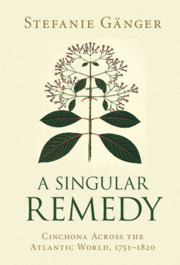Book contents
- A Singular Remedy
- SCIENCE IN HISTORY
- A Singular Remedy
- Copyright page
- Contents
- Illustrations
- Acknowledgements
- A Note on Source Material
- A Note on Language and Translation
- A Note on Weights, Currencies and Measures
- Introduction
- 1 Origin Stories
- 2 The Demands of Humanity
- 3 Community of Practice
- 4 Febrile Situations
- 5 Harvests of Change
- Conclusion
- Bibliography
- Index
Conclusion
A Plant of the World
Published online by Cambridge University Press: 02 October 2020
- A Singular Remedy
- SCIENCE IN HISTORY
- A Singular Remedy
- Copyright page
- Contents
- Illustrations
- Acknowledgements
- A Note on Source Material
- A Note on Language and Translation
- A Note on Weights, Currencies and Measures
- Introduction
- 1 Origin Stories
- 2 The Demands of Humanity
- 3 Community of Practice
- 4 Febrile Situations
- 5 Harvests of Change
- Conclusion
- Bibliography
- Index
Summary
Millions of men and women in societies rimming or tied to the Atlantic basin – be they Ottoman courtiers, Hamburg paupers or Andean villagers – had, by the late 1700s and early 1800s, come to assign medicinal properties as well as particular therapeutic practices and cultural imaginaries to dried shreds of bark removed from the cinchona tree. From Philadelphia to Rome, from Nagasaki to Rio de Janeiro, people had encountered and espoused that singular remedy, as well as techniques and understandings attendant to its consumption, through exposure to the written word, medical practice or word of mouth. Though coming from a single, limited source in the central and northern Andes, the bark would have been available to them through a variety of mercantile conduits and from a wide range of purveyors the world over: on offer from a Frankfurt apothecary, attainable from a Jesuit dispensary in Macao and buyable over the counter of a Smyrna market stand. Many of the bark’s users, traders and supporters would have been conversant with and, in some measure, tempted into its consumption or advocacy by stories about its discovery by ‘wild Indians’ – ‘natural men’ of whom, in their unlettered simplicity, closeness to nature and ‘divine folly’, mankind could reasonably expect the revelation of nature’s most coveted secrets, its most excellent remedies. Many sufferers and medical practitioners would also have shared recipes and medical practices calculated to render cinchona more effectual and agreeable, with its therapeutic properties, powdery texture and nauseous taste entailing a necessity for solvents, sweeteners and the presence of kindred febrifuges and aligning preparations of the bark the world over. Gentlewomen in the Scottish Lowlands, physicians at the Ottoman Porte and Mexican hospital orderlies alike would have known how to concoct, or where to purchase, the classic bittersweet febrifugal lemonades and aromatic compound wines of the bark. Many consumers would have shared not only fanciful narratives about the bark’s discovery and formulae to concoct preparations of it that were palatable, and efficacious, but also diagnostic experience, expertise in indications and an understanding of the environs and ailments in which the use of the Peruvian bark would be most beneficial. From the fenlands of Cambridgeshire to the river valleys of Lima, sufferers and practitioners from all walks of life, be they sailors, householders or seasonal workers, would most commonly have trusted the bark’s protection and curative properties in fevers, occasioned by insalubrious situations and climates. Knowledge, A Singular Remedy holds, is not bound ineluctably to just one place or locality. As the case of the Peruvian bark shows, by the late 1700s and early 1800s, men and women had come to share expertise and experiences across imperial and social divides at a level as fundamental as that of their body, of sickness and cure.
- Type
- Chapter
- Information
- A Singular RemedyCinchona Across the Atlantic World, 1751–1820, pp. 179 - 183Publisher: Cambridge University PressPrint publication year: 2020



